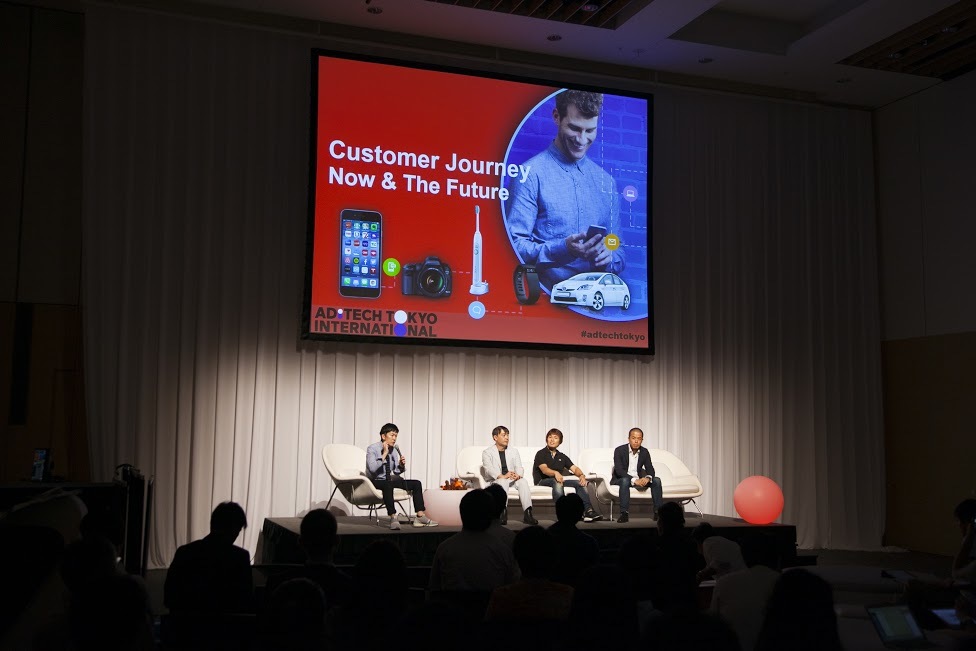AdTech Tokyo International 2015, a global digital marketing event held at Tokyo Midtown Hall in July 2015. Following Part 1, this installment covers the session titled "The Future of the Customer Journey."
Kato: We've heard about the fundamental changes in the customer journey brought about by digitalization and the factors driving them. Next, let's introduce and discuss some advanced initiatives from brands responding to these changes.
Konishi: As mentioned earlier, success today hinges less on media-centric approaches and more on customer-centric strategies. It's about seizing decisive moments that drive purchases and brand connections, sometimes even creating touchpoints, to deliver "branded" experiences.
For example, airlines like JAL and ANA are effectively crafting brand experiences right before boarding—when anticipation for the journey peaks—by providing flight information and smart check-in, including countdown apps (like for Apple Watch). Subaru, meanwhile, seeks to boost loyalty through a unique brand experience: strengthening its user community not just before but after purchase, proposing sports, outdoor activities, and lifestyles. Or take Coca-Cola, a brand well-known to everyone. It seeks to make the "Moment of Happiness" the true moment of the brand. It does this by integrating into people's daily lives through mobile social media and content marketing around sports and music, proposing unique brand experiences. What these have in common is a perspective that goes beyond media touchpoints to capture customers' lives and usage scenarios, focusing on how to create "branded moments."
Suzuki: From the perspective of capturing authentic customer moments, I'd like to highlight New Balance's sponsorship of the "Social Marathon in Shonan International Marathon" program. Here, New Balance went beyond simple sponsorship. In addition to a service automatically posting runners' split times to social media, they offered "MY RACE MOVIE." This allowed each runner to create their own personalized video, packed with their race time, Shonan scenery, and cheers from social media friends. This aimed to make the runners' marathon experience more social and enriching, creating an emotional connection with the brand by sharing their own unforgettable memories. It was very well received.
Tabata: I'd like to share examples of how we created new touchpoints and journey experiences between users and brands through the LINE platform. One example is our global partnership with the luxury brand Burberry. We live-streamed Burberry's London fashion show using LINE Official Account's real-time video feature "LIVE CAST" and also offered collaborative LINE character stamps. Burberry, which is advancing the "democratization" of luxury brands through digital means, leveraged LINE's mass media reach to open up its typically closed fashion show to a much wider audience.
Another example is Recruit's From A Navi, which utilized LINE Business Connect for its official account campaign featuring "Pan-ta Ichiro." This character, powered by Recruit Technologies' natural language processing, enables personal chats with the CM character while searching for part-time jobs. Its witty conversational responses became a major talking point, already amassing over 14 million friends. It truly creates an unprecedented customer journey. Interestingly, looking at actual conversation examples published on summary sites, many involve private consultations about work troubles. The brand successfully builds its personality through personal conversations while also creating engagement (bonds) with users.
Kato: The "Pan-ta Ichiro" case is noteworthy not only for achieving mass-level personalized communication through technology but also for creating an emotional brand experience for consumers.
As such cases suggest, today's mobile and social media platforms are expanding journeys that differ from traditional ones, presenting significant opportunities for brands. So, how should brands respond to these changes in customer journeys? What strategies should they adopt?
Konishi: In fact, most of the communication strategies we execute today follow a customer journey planning process rather than conventional media planning. It begins with "discovering" the moments to connect with each individual customer, rather than just securing media slots to reach the target audience. It involves "designing" unique customer touchpoints that drive the journey. Then, it's about "creating" stories and actions—not just advertising—that allow the brand to connect directly with the customer. Finally, it's about building a continuous "relationship" through the platform.
The key point is that merely accumulating short-term contacts is inefficient and no longer sufficient to guide the journey. It's about building platforms for direct relationships, leveraging external social networks as well. Recently, direct "purchase" buttons have started appearing even in search and social media. Once a brand establishes a "fortress of trust" with its customers, it becomes possible to instantaneously activate the purchasing process when demand arises.
Suzuki: When considering the customer journey, I believe the most crucial aspects are visualizing every touchpoint experience and then discovering and capturing the customer's true moments for the brand. At New Balance, we place particular emphasis on focusing on core brand experiences and scenarios like sports and running, and on creating experiences based on users' emotional insights.
Tabata: The most crucial point to emphasize is that planning should always start with the customer, not with media or frameworks. And as discussed, for a brand, purchase isn't necessarily the goal—it's more the starting point. I believe it's becoming more important than ever to strategize the journey starting from the brand experience.
Kato: So far, we've discussed the definition of the customer journey, its evolution, leading initiatives, and how brands should adapt to these changes. Finally, let's briefly summarize the key points regarding the "Future of the Customer Journey," which is also the theme of this session.

First, as digital technology expands into physical touchpoints, journeys will increasingly occur anytime, anywhere. Beyond smartphones, the growth of wearables, IoT devices like cars, home appliances, and TVs will broaden the opportunities for these journey-initiating interactions.
Second, advancements in technology and personalization will enable more contextually relevant experiences tailored to individual customers. This means brand experiences optimized for time, place, and the customer's behavioral context will increasingly guide the customer journey effectively.
Third, the focus will shift from branded content to branded moments (branded time). As seen in the examples, brands gaining access to and occupying customers' life scenes and time will become more important than content itself.
With that, I'll conclude our session on "The Future of the Customer Journey." Thank you for your attention.










